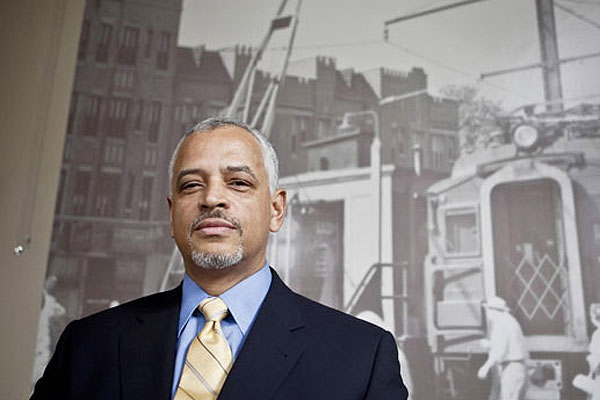
William Farrow, CEO of Urban Partnership Bank
The Trib's Becky Yerak briefly notes that Urban Partnership Bank just opened a Loop mini-branch; I'd noticed it being assembled a couple weeks ago. What's notable about it is that it emerged from the wreckage of ShoreBank, the long-lived community partnership bank, with assistance from Northern Trust, Goldman Sachs (which attempted to help rescue ShoreBank), and others.
Last year, the Chicago News Cooperative's David Greising wrote an excellent account of ShoreBank's collapse, months before it was taken over by the FDIC. It's remarkable how quickly it expanded in the early '90s:
It took ShoreBank until 2000 to accumulate $1 billion in loans. With the new decade and century came a growth drive that was symptomatic of the hard-charging economic times — and ultimately disastrous to ShoreBank’s bottom line. The bank doubled its loan portfolio in four years.
From 2005 to 2007, the bank’s assets grew more than 30 percent, to $2.2 billion. And when Joseph Hasten, a new chief executive, came on board in early 2007, he vowed to quintuple ShoreBank’s lending over the next six years.
And how quickly it fell apart:
At the end of 2006, ShoreBank had a nearly pristine balance sheet. The $2-billion-asset bank had placed only $22 million in loans on non-accrual status — indicating that no interest or principal had been paid for at least 90 days. The current figure is more than 10 times that, $250.7 million in non-accruing loans at the end of March.
Yerak's piece reminded me that more recently, the Stanford Social Innovation Review published a lengthy postmortem for ShoreBank that's likely to be the most detailed account until the FDIC completes its offical postmortem in 2013. It's highly critical of the process that allowed Shore Bank to fail:
The ShoreBank story virtually defines the toxic politics of Washington today. Rather than spend $72 million, with the potential of repayment, to support a bank with a multi-decade track record of adequate liquidity and positive economic development impact—objectives favored by both Democratic and Republican administrations—the Deposit Insurance Fund has been saddled with a loss of more than $330 million. The reason? After ShoreBank was closed, the FDIC entered into a loss-sharing agreement with Urban Partnership Bank in which FDIC absorbed a large share of $329 million of losses to provide the new bank with a healthy balance sheet. (This estimate was revised to $452 million in January 2011.) Meanwhile, the investigation by Rymer, prompted by Republican members of Congress, concluded there was no wrongdoing by either ShoreBank or the FDIC. According to Rymer, the large investors in ShoreBank and Urban Partnership Bank invested “primarily because they believed in ShoreBank’s mission and they did not feel pressure to invest as a result of the FDIC chairman’s calls.”
But it does seem to skirt some of what happened in the attempt to rescue ShoreBank. In brief, here's what happened, from the March report from the FDIC inspector general:
Before ShoreBank failed, the institution engaged in significant capital-raising efforts in the private and public sectors. Late in 2009, the U.S. Department of the Treasury (Treasury) developed the Community Development Capital Initiative (CDCI) program which was designed to support the viability and expansion of financial institutions that promoted access to capital and economic growth in low-income communities across the nation. Shore Bank, the largest certified Community Development Financial Institution in the country, submitted an application for the CDCI program one month after the program standards were finalized.
The FDIC followed its standard process and applied the Treasury's viability criteria in reviewing ShoreBank's CDCI application. DSC conducted a comprehensive analysis to determine a capital level that would be necessary to support lending under worse-than-expected economic scenarios. DSC then recommended ShoreBank for CDCI funding; this recommendation was based primarily on the institution's success in raising a significant amount of private capital as well as substantive changes made to the management team and the Board. The CDCI funding request was denied, and it became apparent the Bank would be closed.
So basically the FDIC made the first cut of community development banks, and the CDCI decided who would get the money. CDCI rejected ShoreBank:
We found that the FDIC followed its standard process and applied the Treasury's viability criteria in reviewing ShoreBank's CDCI application and recommending ShoreBank for funding. ShoreBank was the only composite "5-rated" institution (defined as exhibiting extremely unsafe and unsound practices or conditions) that FDIC recommended for CDCI funding. The primary consideration for the FDIC's positive recommendation was ShoreBank's ability to raise approximately $150 million in private capital. With this capital, ShoreBank met four of the six required performance ratios specified by the Treasury. Ultimately, the CDCI Interagency Council disagreed with the FDIC's view and concluded that ShoreBank needed additional capital to be viable and recommended against, and ShoreBank did not receive, CDCI funding.
How short were they?
While the FDIC provided an assessment showing that ShoreBank needed between $175 and $202 million to be viable, based on the capital analysis described above, the FRB [Federal Reserve Board] and OCC [Office of the Comptroller of the Currency] decided that the bank needed at least $100 million more in capital than what the FDIC estimated in order to recommend ShoreBank for CDCI funding.
Reading the FDIC report, it sounds like Shore Bank was a borderline case:
• ShoreBank met four of the Treasury's six performance ratios when both private capital and CDCI funds were considered.
• Ten banks met all of the Treasury's performance ratios on a stand-alone basis.
• Three banks met five out of six of the Treasury's performance ratios on a standalone basis.
Had the bank been less politically charged, perhaps it could have survived its borderline financial situation; had it not been in a borderline situation, perhaps it could have survived the politics.
Photograph: Chicago Tribune



